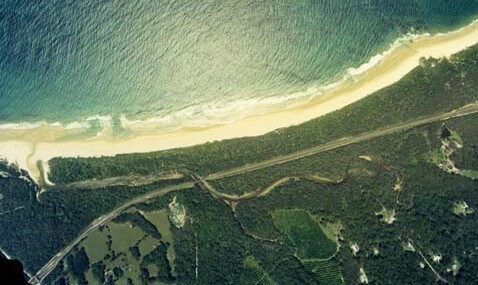Dalhousie Creek estuary is a small lagoon with an intermittently closed/open entrance. The estuary meets the sea at Hungry Head on the mid-north coast of New South Wales.
Water quality report card
As part of our water quality monitoring program we assess the water quality and ecosystem health of an estuary using a range of relevant indicators. We sample a subset of the estuaries located between the Queensland border and Taree every 3 years. The most recent sampling in Dalhousie Creek was completed over the 2018–19 summer, when 2 sites were sampled on a monthly basis.
This report card represents 2 water quality indicators that we routinely measure: the amount of algae present and water clarity. Low levels of these 2 indicators equate with good water quality.
Algae
Water clarity
Overall grade
The report card shows the condition of the estuary was excellent with:
- algae abundance graded excellent (A)
- water clarity graded excellent (A)
- overall estuary health graded excellent (A).
Grades for algae, water clarity and overall are represented as:
- A – excellent
- B – good
- C – fair
- D – poor
- E – very poor.
Go to estuary report cards to find out what each grade means, read our sampling, data analysis and reporting protocols, and find out how we calculate these grades.
We have monitored water quality in the Dalhousie Creek since 2015. This table shows the water quality grades for this estuary over that time.
| Year | Algae | Water clarity | Overall grade |
|---|---|---|---|
| 2012–13 | A | A | A |
| 2015–16 | A | A | A |
Physical characteristics
| Estuary type | Lagoon |
|---|---|
| Latitude | –36.49 (ºS) |
| Longitude | 150.06 (ºE) |
| Catchment area | 53.1 km2 |
| Estuary area | 1.3 km2 |
| Estuary volume | 1130.3 ML |
| Average depth | 0.9 m |
Notes: km2 = square kilometres; m = metres; ML = megalitres.
Water depth and survey data
Bathymetric and coastal topography data for this estuary are available in our data portal.
Land use
Around three quarters of the Dalhousie Creek catchment remains forested despite an absence of conservation areas. The upper catchment west of the Pacific Highway is managed by Forestry Corporation. The creek flows through low-density rural-residential areas interspersed with grazing and horticulture, which combine to make up around 25% of land use.
National and marine parks
- No national parks exist within the Dalhousie Creek catchment.
- This estuary does not flow into a marine park.
Community involvement
- Bellinger Landcare provides workshops and volunteer work opportunities throughout the Bellingen Shire and beyond.

Aerial view of Dalhousie Creek estuary
Local government management
Local councils manage estuaries within their area unless the estuary is attached to a marine park. Dalhousie Creek is managed by Bellingen Shire Council.
Threatened species
Threatened species exist in the Dalhousie Creek catchment, including shorebirds like pied oystercatchers, which are sometimes seen around the entrance to the estuary.
Read more about the biodiversity in our estuaries.